




surf ' s up! Compliments of Yogesh Khare ISSUE 123 Yogesh Khare, Team Lead | Founder REALTOR® DRE #02044237 (408) 888-3855 California Khare Real Estate Group Los Altos, CA 94022 ISSUE 123 COVER PRICE $6.99 123 53939 38501




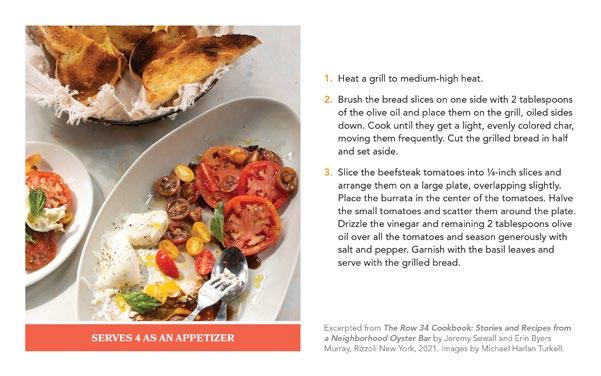

tear off your y Reci pe Card. I kolo rof drwa ot ginrahe morf .uoy ogeshY eKhar (408) 888-3855 Yogesh@Califor niaKhare.com www.YogeshKhare.com and www.CaliforniaKhare.com California Khare Real Estate Group Los Altos, CA 94022 opT Agents in Bay eaAr (408) 888-3855 ogesh@CaliforY e.comniaKhar www e.comogeshKharY and orlifCa.www e.comniaKhar orlifk.com/Caaceboo niaKhar
321 53939 38501
of Tear Out Card 1 Back of Tear Out Card 1
Yogesh Khare Team Lead | Founder REALTOR® DRE #02044237
Front
Welcome to American Lifestyle magazine
American Lifestyle is a celebration of the flavor and flair of life in the United States, that takes the reader on a journey of the nation's sights, sounds, smells, and tastes. This 48-page publication features articles on interior design, travel, technology, restaurants, and culture
Entertaining writing coupled with gorgeous photography makes this magazine a must read
This magazine provides me with the chance to connect with all of the friends and clients that I have had the opportunity to know over the years. If you are interested in receiving your own free subscription of this magazine please e-mail or call me with your name and home address, and I will add you to my mailing list. It is delivered to your home ever y other month with no obligation.
Feel free to share this issue with friends and colleagues and encourage them to reach out to me I would love to hear what they think of American Lifestyle magazine too.
I look for ward to hearing from you
Yogesh Khare
Yogesh Khare Team Lead | Founder

REALTOR®
DRE #02044237
A Home You Will Love!
Top Agents in Bay Area
(408) 888-3855
Yogesh@Califor niaKhare.com
www YogeshKhare.com and www Califor niaKhare.com
Facebook: https://www.facebook.com/Califor niaKhareGroup
California Khare Real Estate Group Los Altos, CA 94022


AMERICAN LIFE STYLE ISSUE
3 4 10 16 24 30 38 44 48

DOWNSIZING MADE EASY CONGEALED CONNECTIONS BRIDGING THE PAST AND PRESENT SOULFUL AND SATISFYING INNER GEOMETRY SOUTHERN-STYLE HOME MAKEOVER
NEW MEXICO'S MUST-SEE LANDMARKS ACCESSIBLE LUXURY COASTING IN COLORADO

123
PUBLISHER
Chief Executive Officer Steven Acree publisher@remindermedia.com
EXECUTIVE President Luke Acree
Chief Marketing Officer Joshua Stike
Chief Operating Officer Michael Graziola
MARKETING
Director of Marketing Dan Acree
Director of Creative Services Kristin Sweeney
Director of Content Jessica Fitzpatrick marketing@remindermedia.com
EDITORIAL
Editorial Manager Alexa Bricker
Senior Editor Matthew Brady
Senior Designer and Writer Shelley Goldstein
Content Writers Lauren Kim, Bonnie Joffe, Andre Rios editorial@remindermedia.com
SALES AND CLIENT SUCCESS
Vice President of Client Success Ethan Acree
Vice President of Operations Nicholas Bianco
Vice President of Sales Michael Campanile hello@remindermedia.com
OPERATIONS
Vice President of IT Thomas Setliff
Director of Manufacturing Shannon Mosser
Director of Business Intelligence Daniel Gallaway
Director of Projects Kelsie Schmall
Vice President of Finance Shana Lebofsky
Director of HR John Keogh hr@remindermedia.com
American Lifestyle is published by ReminderMedia. For more information about American Lifestyle, please visit us at www. remindermedia.com, email us at info@remindermedia.com, or call us at 866-458-4226. All rights reserved.
NO PART OF THIS PUBLICATION MAY BE REPRODUCED WITHOUT THE EXPRESSED WRITTEN CONSENT OF THE PUBLISHER
This magazine is for information and entertainment purposes only; it is not an attempt to solicit business.

Designed and printed in the USA.
DOWNSIZING MADE EASY
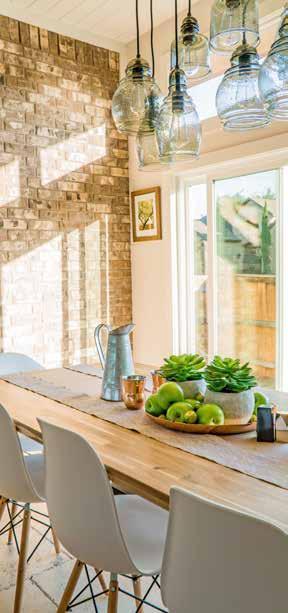 written
written
WHEN I MOVED FROM SEATTLE TO THE East Coast, I sold all my furniture and started fresh in Pennsylvania. New furniture prices had skyrocketed, though, so I needed a more affordable route to furnishing my space. Enter CTBIDS, an online auction of sorts that a friend suggested. It’s part of the offerings by Caring Transitions, a company established in 2006 to help older adults and their families downsize, transition to assisted living, or liquidate a household.
The online bidding is simple to learn, and you can even set a maximum bid and the system will automatically bid for you. Bidding for all items begins at one dollar, and most auctions run for one to two weeks. Best of all, from
furniture to housewares to jewelry, you never know what you might find. I lucked out with a vintage sideboard for $100 and a $400 Kartell globe pendant for $65. An email alerted me to my wins and supplied an address and time window to pick up my items.
Caring Transitions’ owners across the country help the auction and liquidation run smoothly, ensuring all items go to their new purchasers. With over two hundred locations nationwide, CTBIDS has a midcentury lamp with your name on it.
For more info, visit ctbids.com

2 | AMERICAN LIFESTYLE MAGAZINE americanlifestylemag.com | 3
by shelley goldstein digital art by rose wonder studio
“BIDDING FOR ALL ITEMS BEGINS AT ONE DOLLAR, AND MOST AUCTIONS RUN FOR ONE TO TWO WEEKS. BEST OF ALL, FROM FURNITURE TO HOUSEWARES TO JEWELRY, YOU NEVER KNOW WHAT YOU MIGHT FIND.”
Photo by Mark McCammon
CONGEALED CONNECTIONS
MY GRANDMA FOOF (NAMED FOR HER inability to whistle) wasn’t much of a cook, but she had her specialties. Blintz casserole—two pans of blueberry and two pans of cheese—was a staple of weekend brunches at my grandparents’ sprawling midcentury home. And beside the custardy blintz soufflés was always a gelatin mold in all its glossy, wiggly glory. There was a whole procedure for unmolding that involved hot water and my grandma giving a live play-by-play as to the status of the congealed goo’s eventual descent onto the fancy china. My grandma would yell a joyous “Yay!” and clap her hands. As a kid, there was nothing more exciting.
Generations of people have their own nostalgic stories about Jell-O—its invention and ultimate ubiquity are woven into the fabric of America. In fact, its transformation from elitist food of high society to a staple of the 1960s family table follows the thread of history through the industrialization of food production, two world wars, and shifting expectations of women in a postwar kitchen.
GELATIN FOR THE ELITE
Gelatin showed up on the scene way back in medieval Europe. Long before the advent of the instant Jell-O we know today, making gelatin dishes was an extremely time-consuming process because collagen had to be rendered from animal bones and then clarified. Gelatin dishes also signaled wealth and a kitchen staff. The same held true when gelatin made its way to the American colonies. At Monticello, the primary estate of Thomas Jefferson, wine jelly made an appearance on the menu when hosting guests.
GELATIN IN AN INSTANT

Steam locomotive inventor Peter Cooper experimented with large sheets of gelatin, grinding them into a powder and dubbing it “Portable Gelatin.” It was revolutionary—all one needed to do to make gelatin was add hot water. Though his patent was approved, the
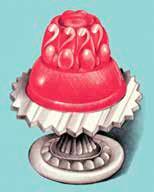
PICTURED ABOVE: A vintage Jell-O recipe made with ginger ale, orange juice, and orange Jell-O.
TASTER COMMENTS: Enjoyable and resilient! The three packets of orange Jell-O made for a very firm gel reminiscent of Jell-O jigglers.

americanlifestylemag.com | 5 4 | AMERICAN LIFESTYLE MAGAZINE
written by shelley goldstein photography as noted
THE NOSTALGIA OF JELL-O CONNECTS US ALL TO OUR HISTORY, BOTH PERSONAL AND COLLECTIVE.
“There was a whole procedure for unmolding that involved hot water and my grandma giving a live play-by-play as to the status of the congealed goo’s eventual descent onto the fancy china.”
© Shelley Goldstein
Photo by Getty Images
Photos by Getty Images
product didn’t exactly take off, perhaps because Cooper was more interested in producing glue. But fifty-two years later, in 1897, carpenter and cough syrup producer Pearle Bixby Wait created a fruit-flavored dessert that his wife, May, dubbed Jell-O. It was a combination of the words gelatin and jelly, and the “O” was added as a common practice in product naming at the time.
After an underfunded and unsuccessful marketing attempt, Wait sold the Jell-O trademark to the Genesee Pure Food Company. The company capitalized on the food-advertising themes at the time, which prioritized food purity, hygiene, sanitation, and scientific production. The ethos of women’s labor mirrored these ideas of cleanliness and efficiency. There was no better time for the concept of instant gelatin to launch. And launch it did, as the company saw sales take off in 1902.
GELATIN SALADS ABOUND
Ladies’ Home Journal and other popular magazines at the time ran ads for Jell-O, touting it as “America’s Favorite Dessert.” The ads were incredibly successful, driving up sales and even spurring entire Jell-O cookbooks. Genesee also hired a then-unknown artist named Norman Rockwell to illustrate scenes of their product. In 1924, the Genesee Pure Food Company rebranded as the Jell-O Company.
PICTURED:
A vintage Jell-O salad recipe made with cabbage, grapefruit, orange, scallions, and lime Jell-O.


TASTER COMMENTS: This tasted as terrible as you would think, perhaps even worse if you got a bite with scallion in it. Works best as an art piece to entertain dinner guests.
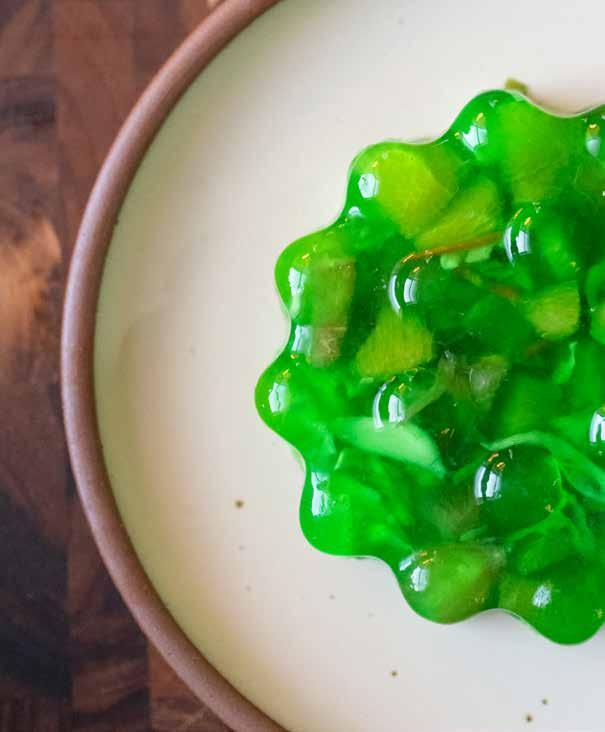
6 | AMERICAN LIFESTYLE MAGAZINE americanlifestylemag.com | 7
“[JELL-O] MADE USE OF THE FRESH FRUITS AND VEGETABLES THAT WERE GAINING IN POPULARITY AT THE TIME.”
All photos © Shelley Goldstein
During the Great Depression, Jell-O was a cheap source of protein and a way to make food look visually appealing. It also made use of the fresh fruits and vegetables that were gaining in popularity at the time.
The instant and processed food products manufactured out of necessity during World War II changed the landscape of food preparation, and afterwards, advertisers continued to use marketing ideas of efficiency to sell Jell-O. But efficiency collided with an expectation that housewives should put more care into the meals they were preparing. To bridge this contradiction, women focused on presentation and extra ingredients, like adding cream into the gelatin to create an opaque layer or making a frosting of shrimp and mayonnaise. And shaped molds made it easy to create impressivelooking displays with minimal effort. To match the trend, Jell-O rolled out flavors like lime, celery, mixed vegetable, and tomato.
GELATIN FINDS ITS HOME
By the 1970s and 1980s, sugar was being looked at as unhealthy, and Jell-O salads began to fade. Women were entering the workforce in growing
numbers, and gelatin-based salads took too long to prepare. Jell-O began focusing on desserts and snacks, and that trend continues to this day, with over 420 million boxes of Jell-O gelatin and over one billion Jell-O cups being sold in the United States per year.

Jell-O is so much a part of history that a museum devoted entirely to this jiggly marvel opened in 1997 in Le Roy, New York, the same town where Pearle Wait lived. Old recipes passed down from generation to generation led one woman to create a blog of midcentury Jell-O recipes that she tested and tasted to varying degrees of horror or delight.
Even though I only ate the top two layers of my grandma’s Jell-O, picking around the unappetizing bits of fruit cocktail carefully suspended in the bottom layer, I miss the ritual of her molds, the shared bonding of a task at hand, and her delight when the wiggly mass slid its way out of the green plastic ring. The sight of Jell-O is now inextricably entwined with my memory of her, and it is this connection that will ensure gelatin will be introduced to generations to come.
americanlifestylemag.com | 9 8 | AMERICAN LIFESTYLE MAGAZINE
“Jell-O began focusing on desserts and snacks, and that trend continues to this day, with over 420 million boxes of Jell-O gelatin and over one billion Jell-O cups being sold in the United States per year.”
Photos by Getty Images
“SHAPED MOLDS MADE IT EASY TO CREATE IMPRESSIVE-LOOKING DISPLAYS WITH MINIMAL EFFORT.”
BRIDGING THE PAST AND PRESENT
written by matthew brady | photography by getty images
I LIVE IN BUCKS COUNTY, PENNSYLVANIA.
Among other things, this quaint area in the southeastern part of the state is known for its culture, its scenery, and especially its history—there are seemingly endless examples of historic homes, castles, and mansions for both residents and visitors to indulge in.
Among these notable centuries-old structures are covered bridges. In fact, there are still a dozen scattered across the county. Having one in our town, I can vouch from firsthand experience that driving through a historic covered bridge fills you with a sense of awe.

But what exactly makes them so magical to the point that they are romanticized in photos, paintings, books, and movies? Once you deconstruct the history and function of covered bridges in America, you can better understand why the stillstanding ones are such a fixture in the fabric of our identity.
THEIR PRACTICAL PURPOSE
Back in the early 1800s, America was in its infancy and the country’s enormity was still being explored, which required much travel. As such, it also required finding ways for horses and buggies to cross over bodies of water—hence the construction of bridges. Wood was plentiful thanks to vast forests of virgin timber, resulting in wooden bridges appearing throughout the country.
The problem? Wood and weather don’t always mix well, so the bridges would usually last a few years, tops. The solution? Adding a cover, which would help protect the precious load-bearing timber and prolong the structure’s life. The United States’ first fulllength covered bridge, the ironically named Permanent Bridge, was built in Philadelphia in 1805. It stood for seventy years.
TRUSTING THE TRUSS
Most historic bridges in America feature a truss design. In fact, truss bridges have been used for centuries, and that’s not accidental: they’re a popular choice for their strength. For greater support, truss designs use beams connected in a triangle, which evenly distribute the weight they absorb. Such engineering can be simple, but over the years, many elaborate truss designs have been patented to account for increasingly longer bridges with higher weight loads—allowing covered bridges to flourish in nineteenth-century America.
COUNTRYWIDE COVER
At their peak, approximately 14,000 covered bridges dotted the United States. Today, thanks to the influx of concrete and steel, the number of historic wooden covered bridges has dwindled to six hundred or so. Being such a rare historical find, they’re well worth a visit, and you could even help contribute to their preservation if you’re duly inspired.
10 | AMERICAN LIFESTYLE MAGAZINE americanlifestylemag.com | 11
NOTHING CAPTURES THE HISTORICAL IMAGINATION QUITE LIKE AMERICA'S COVERED BRIDGES.
PICTURED: Sach's Bridge
Here are some of the most noteworthy historic covered bridges to add to your travel to-do list, all of which are listed on the National Register of Historic Places.
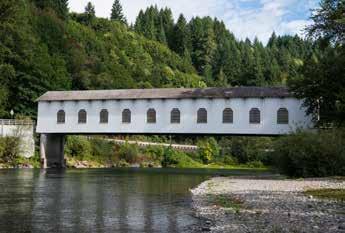
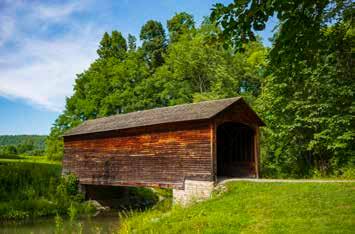
The oldest:
Hyde Hall Covered Bridge (New York)
Situated in New York’s Finger Lakes is the oldest documented covered bridge in the country, Hyde Hall Covered Bridge. Why the name? When it was built in 1825, it was on the property of a country mansion called Hyde Hall. The state acquired both in 1963 and incorporated them into Glimmerglass State Park, where they can be found to this day.
The longest:
Cornish-Windsor (Vermont–New Hampshire) or Medora (Indiana)
According to the National Society for the Preservation of Covered Bridges, the longest historic covered bridge in America is a matter of debate, or at least definition. The Cornish-Windsor Covered Bridge has a longer truss and is considered to be the longest two-span historic covered bridge in the world, but Medora Covered Bridge actually has a greater overall length. You’ll have to visit both to make your own determination!
Not to be outdone, the longest historic single-span wooden truss bridge in North America is the Bridgeport Covered Bridge in California, which was closed for a decade for much-needed repairs but reopened in 2021.

The most state-connecting:
Cornish-Windsor and friends
The Cornish-Windsor Covered Bridge is also one of only three covered bridges in America (along with the Columbia Covered Bridge and the Mount Orne Covered Bridge) that span two states. All three cross the Connecticut River between New Hampshire and Vermont.
The tallest:
Felton Covered Bridge (California)
Located near San Jose and built in 1892, this thirty-fivefoot-tall structure is available for pedestrian traffic only, which is a good thing—it leaves you more time to gaze up at its sheer expanse.
The quirkiest:
Humpback (Virginia), Sach’s (Pennsylvania), and Goodpasture (Oregon)
Humpback Bridge stands out because it’s true to its name, with its middle section rising four feet above its entrances. Constructed in 1857, it’s the fourth version of the bridge and is the oldest bridge in the state.
Sach’s Covered Bridge, located in historic Gettysburg, was a key conduit during the Civil War. Today, the hundred-foot-long structure stands out for its intricate latticework, which gives the illusion that it has two stories.
The popular and picturesque
Goodpasture Covered Bridge in Vida, Oregon, is a bit younger than other historic bridges in this guide, having been constructed in 1938. Photographers love to shoot here not only for the scenery but also because of the bridge itself, with its arched louvered windows giving it a chapel feel.
12 | AMERICAN LIFESTYLE MAGAZINE americanlifestylemag.com | 13
“PHOTOGRAPHERS LOVE TO SHOOT HERE NOT ONLY FOR THE SCENERY BUT ALSO BECAUSE OF THE BRIDGE ITSELF, WITH ITS ARCHED LOUVERED WINDOWS GIVING IT A CHAPEL FEEL.”
PICTURED CLOCKWISE FROM TOP LEFT: Hyde Hall, Goodpasture, Felton Bridges
The most festive:
Stark Covered Bridge (New Hampshire)
Every year, the town of Stark, New Hampshire, lights up its historic covered bridge and the tiny, historic Stark Union Church next to it to create a one-of-a-kind holiday scene. Bonus fun fact: In the 1890s, this bridge was washed away by high water. Undaunted, men from the town used oxen to bring it back and then set it on stronger stone piers, illuminating the bridge’s importance to the town.
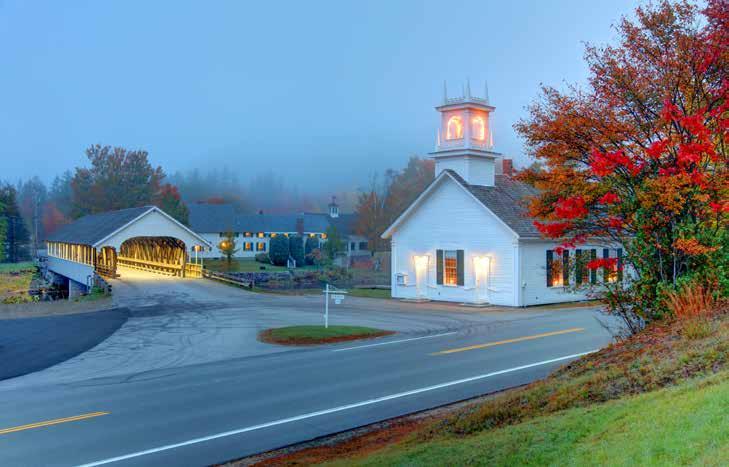
The pop culture icon:
Roseman Covered Bridge (Iowa)
This structure, which played a prominent role in the romantic novel and movie The Bridges of Madison County, is one of six covered bridges in the area. It’s also rumored to be haunted, which probably didn’t work as well in the manuscript.
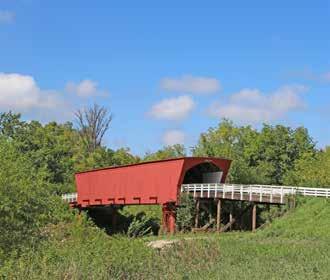
Covered bridges are longstanding testaments to not only America’s romanticism and nostalgia but also its work ethic and ingenuity. These monuments span both bodies of water and centuries, providing instantaneous connection between the country’s past and present for all who pass through them.
For more info, visit coveredbridgesociety.org
14 | AMERICAN LIFESTYLE MAGAZINE americanlifestylemag.com | 15
“In the 1890s, [the Stark Bridge] was washed away by high water. Undaunted, men from the town used oxen to bring it back and then set it on stronger stone piers, illuminating the bridge’s importance to the town.”
PICTURED LEFT TO RIGHT: Stark Bridge and Roseman Bridge
SOULFUL AND SATISFYING
There is probably no more polarizing a dish in traditional soul food culture than mac and cheese. Historically, it has been the cause of innumerable fistfights, insults, snubs, irreparable family rifts, and divorces. I offer my rendition as a way to heal all of the aforementioned: a delicious sort of peace treaty with crushed Hot Cheetos on top. If this recipe doesn’t heal old wounds—or, worse yet, opens them up and causes new ones—just remember: You didn’t get it from me.

hot mac ‘n’ cheese
INGREDIENTS
2 pounds macaroni pasta
½ pound unsalted butter
1/3 cup all-purpose flour
4 cups whole milk
¾ teaspoon onion powder
¾ teaspoon black garlic powder, preferably, or garlic powder
1 teaspoon freshly ground black pepper
12/3 pounds shredded Velveeta cheese
2¼ cups sour cream
21/3 cups cottage cheese
1½ teaspoons cayenne pepper
8 to 12 ounces Hot Cheetos, crushed
Serves 8–10
1. Cook the macaroni according to the package directions.
2. To make the sauce: Slowly melt ¼ pound of the butter in a large, heavy-bottomed pot over medium heat. Whisk in the flour, stirring frequently to make a golden roux. Slowly pour in the milk, stirring constantly until a smooth bechamel sauce has been achieved.

3. Add the onion powder, garlic powder, and black pepper. When the sauce comes to a simmer, add the Velveeta, one handful at a time, allowing each handful to melt into the sauce before adding more.
4. Reduce the heat to low and stir in the sour cream and cottage cheese in a similar fashion, allowing each batch to melt into the sauce before adding more. When the sauce is smooth, remove it from the heat and stir in the remaining butter and the cayenne pepper.
5. Drain the cooked macaroni and divide it among individual bowls. Pour the sauce over the pasta, top with about 1 ounce of Cheetos, and serve.
americanlifestylemag.com | 17 16 | AMERICAN LIFESTYLE MAGAZINE
recipes by justin sutherland photography by asha belk
RECIPES FROM NORTHERN SOUL BY JUSTIN SUTHERLAND. © 2022 QUARTO PUBLISHING GROUP USA INC. TEXT © 2022 JSUTHERLAND LLC. PHOTOGRAPHY: ASHA BELK.
bourbon mussels
INGREDIENTS
4 bacon slices, chopped
8 ounces andouille sausage
4 Fresno chiles
4 garlic cloves, minced
2 medium shallots, coarsely chopped
8 ounces bourbon
2 (15.5 ounce) cans whole tomatoes, drained and coarsely chopped
1½ teaspoons crushed red pepper
1 teaspoon liquid smoke
3 pounds fresh mussels in their shells, such as PEI mussels or your favorite variety
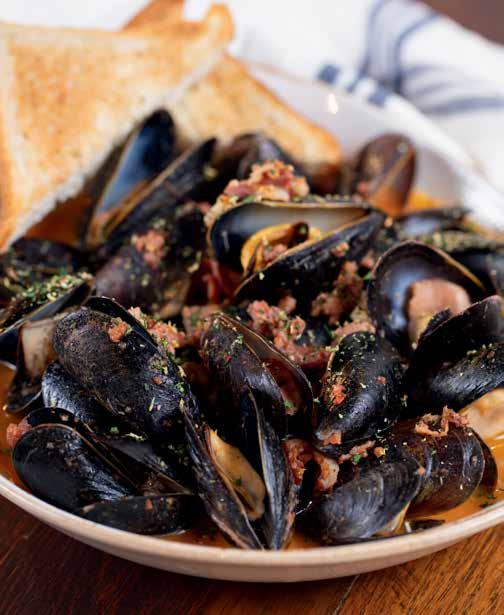
9 ounces butter
Salt and freshly ground black pepper to taste
1 bunch flat-leaf parsley, chopped
4–6 lemon wedges
Serves 4–6
1. Cook the bacon in a large skillet or Dutch oven over medium heat until it renders its fat and is brown and crisp, about 6 minutes. Add the andouille and cook about 6 minutes more, until the sausage is nicely browned.
2. Add the Fresno chiles, garlic, and shallots and cook for 2 minutes more, until the vegetables start to soften. Add the bourbon and use it to deglaze the pan for 2 to 3 minutes, until the alcohol has burned off. Add the tomatoes, crushed red pepper, and liquid smoke, bring to a boil, then immediately reduce to a simmer.
3. Add the mussels, cover the pan, and steam for 5 to 7 minutes, until the shells open. Once they have opened, add the butter to the sauce and stir to incorporate it. Add salt and pepper to taste. Garnish each serving with parsley and serve with a fresh lemon wedge.
18 | AMERICAN LIFESTYLE MAGAZINE americanlifestylemag.com | 19
Be sure to have some crusty bread close by so you can sop up all this bourbon-laced sauce.
Biscuits can be the meal, or they can round out the meal. They can begin or end your hardworking day. Biscuits are one of the first things I learned to make when I was young. They are a great meal prep to share with the little ones in your family because they are hands-on, require some gentleness, get better with lots of practice, and are the right amount of messy—like all of the best things in life.
buttermilk biscuits

INGREDIENTS
10 tablespoons unsalted butter
3 ounces lard or vegetable shortening
6 cups all-purpose flour
¼ cup baking powder
2 tablespoons kosher salt
1 tablespoon baking soda
3 cups cold buttermilk
½ cup minced fresh chives
1 cup shredded sharp cheddar
1 cup cooked and chopped bacon, from about ½ pound uncooked bacon
Makes 8–10 biscuits
1. Cut the butter and lard into pea-sized pieces and freeze in a covered container for about 30 minutes. Meanwhile, preheat your oven to 350°. Grease a baking sheet.
2. Sift together the flour, baking powder, salt, and baking soda in a large bowl. Using a pastry cutter or your fingertips, cut the butter and lard into the dry ingredients until the mixture has the consistency of coarse sand.
3. Make a well in the center of the bowl and pour in the buttermilk, chives, cheddar, and bacon. Using your hand or a wooden spoon stir together until a shaggy dough just comes together. Important: do not overwork the dough. Turn the dough out onto a lightly floured surface, dust the top with flour, and gently fold the dough over itself eight times.
4. Flatten the dough into a 1½-inch thick rectangle and cut into 3-inch by 3-inch squares. Arrange the biscuits on the greased baking sheet at least 1 inch apart.
5. Bake for 15 to 20 minutes, until the tops are golden brown and the centers are cooked through. Serve warm.
americanlifestylemag.com | 21 20 | AMERICAN LIFESTYLE MAGAZINE
These puddings, served individually in glasses or jars, are a champion choice for the kind of gathering you know is going to last into the wee hours. They are so easy to make and store, chilled, ahead of time, and to simply unwrap and set out on the table with a pile of spoons and paper napkins.
super easy peanut butter banana pudding

INGREDIENTS
5-ounce pack instant vanilla pudding
2 cups whole milk
8 ounces cream cheese, at room temperature
2/3 cup creamy peanut butter
8 ounces Cool Whip or other store-bought whipped topping
1 cup heavy cream
2 tablespoons powdered sugar
1 teaspoon pure vanilla extract
1 cup crumbled store-bought vanilla wafers
3 bananas, thinly sliced
Makes 6 individual puddings
1. Combine the pudding mix and milk in a mixing bowl and whisk until smooth. With an electric mixer in a separate bowl, beat the cream cheese with the peanut butter until smooth, then fold in the Cool Whip. In a third bowl, beat the heavy cream, powdered sugar, and vanilla until the cream forms soft peaks.
2. Set six rocks glasses, lowball glasses, or mason jars on a countertop. Use one-third of the vanilla wafers to line the bottoms of the glasses or jars. Top with half of the peanut butter and cream cheese mixture, then half of the banana slices, followed by half of the vanilla pudding. Repeat the layers one more time, then top with whipped topping, the remaining banana slices. Sprinkle the remaining vanilla wafers over the tops. Store in your refrigerator until ready to serve.
americanlifestylemag.com | 23 22 | AMERICAN LIFESTYLE MAGAZINE
INNER GEOMETRY
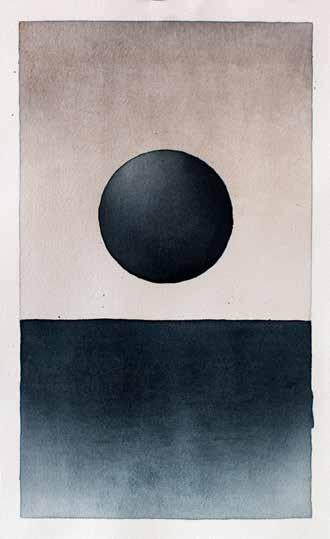
What did the path to becoming an artist look like for you?
Like every kid, I was born an artist. I feel really lucky to have parents that always nurtured my creative interests. I took every art class I could in high school and got a bachelor of fine arts in graphic design. I worked at a boutique design firm in Los Angeles before transitioning to freelance design and illustration. As I started to focus more on painting, I was able to phase out of the design world.
Have you always lived in California? How does this place inform your work?
I was born in California, but it took me nearly twenty years to come home after spending most of my childhood in Minnesota. I never lost my connection to the coast, and I feel so grateful to have taken up surfing when I moved back to Los Angeles after college. I get so much energy and inspiration from my time in the ocean. There’s really no substitute for sunshine and salt water.
Was there pressure to find a specific style and stick to it?
I definitely felt pressure to find a clear voice and commit. But at some point, I decided to focus more on what I wanted to express than how I wanted to express it. Allowing myself the freedom to change how I share keeps
me in the game, as does freedom in general. The tighter the confines, the more likely I am to want to check out.
How does your style continue to evolve? What is your process for beginning a new series?
My work is heavily driven by my meditations and writing. The themes that emerge in my personal life through these reflections often become new series. I’ll spend time writing about what it is that I want to explore and then sublimate those ideas into simple shapes in my sketchbook. Sometimes I have plans for a set of works, but often the writing and sketching blend together and create a vocabulary that I pull from when I sit down with a blank sheet or canvas.
The titles of your series are so thoughtful and intriguing. What inspires the names?
Inner Architecture is a series of watercolor paintings that compares the process of self-development to building and renovating a three-dimensional structure. Letters to My Unmet Self are totemic paintings made up of a few really simple glyph forms, exploring what it might look like to write love notes in a secret language to someone I haven’t met yet. It was partly inspired by the poetry that I’ve written all my life about (and to) people who may not even exist. And it is also partly about romancing the soulmate of the self. Since part of the rush of falling in love is seeing ourselves through the fresh eyes of someone new, this process of courting the other is just as much about courting ourselves.
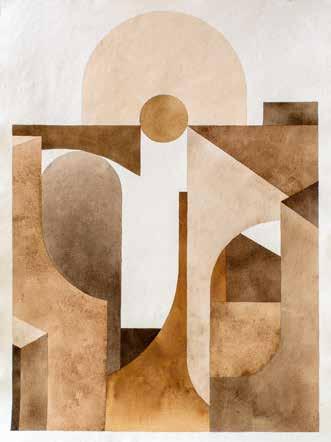
americanlifestylemag.com | 25 24 | AMERICAN LIFESTYLE MAGAZINE
interview with allison kunath written by shelley goldstein photography as noted
ARTIST ALLISON KUNATH LOOKS TO HER INNER LANDSCAPE TO INFORM THE MARKS SHE MAKES WHEN PAINTING.
In what type of environment are you most productive?
Close proximity to the water. Minimal distractions with just a little highquality social stimulation. Lots of quiet and unscheduled time. High ceilings. Bright natural light.
What is your favorite art medium and paper?


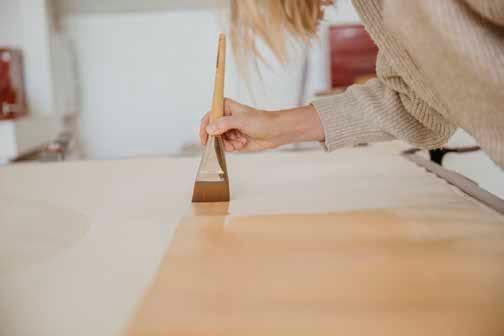
Daniel Smith watercolors and Arches watercolor paper. Sometimes I get lucky and find special handmade papers—that’s even better.
You also do murals. What do you find most challenging about them? The days are long and physical and
can be exhausting. I get excited about their completion, so I find it really challenging to pace myself, take proper breaks, and end my days at a reasonable hour, especially when I still have more energy to use.
You have worked with some bigname clients, including Starbucks and Lululemon. How did you get your first gig? Was there a moment when you felt like you “made it”? My first murals were donations, and I used them essentially as experiments. I feel grateful that people were willing to let me take a crack at the concept on their walls. When larger projects started to roll in more consistently, I definitely felt a type of pride and security I hadn’t experienced before (or expected, to be honest). But I think the concept of “making it” as an artist is kind of funny. The way I view this lifestyle is as one of constant revision— always a work in progress, always a new question to answer. It’s the nature of innovation. “Making it” gets tricky with a moving target.
Do you have advice for artists who struggle with impostor syndrome? Try to remember that no one is immune from this trick of the mind. We’ve all felt it. Just keep going anyway.
Do you go through phases of being uninspired? How do you break through artist’s block?
I often do. Inspiration is like a tide that ebbs and flows. I do my best to appreciate that when the tide is low, there are important bits that are finally visible that I usually don’t see when the water is rushing. I take a lot of notes during these times and spend extra time doing other things that bring me joy, and the desire to create always comes back.
26 | AMERICAN LIFESTYLE MAGAZINE americanlifestylemag.com | 27
“Inspiration is like a tide that ebbs and flows. I do my best to appreciate that when the tide is low, there are important bits that are finally visible that I usually don’t see when the water is rushing.”
© Renee McMahon
© Yana Yatsuk
Do you have a bucket list for art?
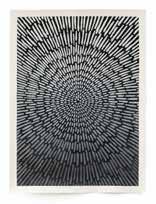


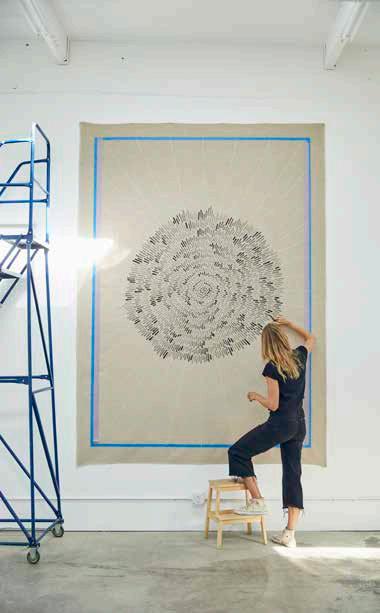
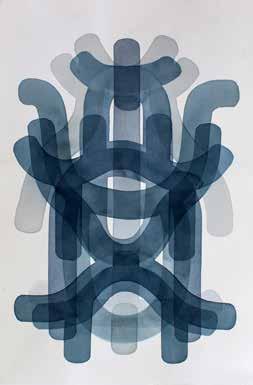
To be honest, I don't. My choice to pursue art full-time was coupled with detaching from the pressure of concrete goals and mile markers. At that time, I was living paycheck to paycheck, and simply being able to survive as an artist surpassed every goal I had ever set in the past. Of course, I'm not immune to comparison or generally longing for more, but that sense of early accomplishment set me up for a career orientation that is more focused on process than results. I evaluate my progress based largely on how I feel in my body and my practice every day.
What kind of people do you like to surround yourself with?
Most of my closest friends are funny, expressive, tenderhearted, generous weirdos who skew toward athletic and adventurous. I feel happiest when my days are slow and full of creating, surfing, meditating, and laughing and eating with friends.
In an alternate reality, what would you do?
My current life—making art while traveling and exploring where I most want to live—is feeling pretty good to me. But if the alternate reality can make me an heiress, I’ll take it.
For more info, visit allisonkunath.com or @allisonkunath on Instagram
28 | AMERICAN LIFESTYLE MAGAZINE americanlifestylemag.com | 29
© Ty Cole © Ty Cole
© Renee McMahon
HOME MAKEOVER SOUTHERN-STYLE

How did you develop a love for interior design?

My mom spent a lot of time redecorating our home when I was growing up. She had such a love for home decor that she often said she wished it was her profession. This also inspired me at a young age when I began asking if I could redecorate my room; she was supportive and encouraged me to explore concepts on my own and to not be afraid of selfexpression. In high school, I excelled in an interior design class, and it solidified my decision to pursue this as a career.
When did you start Leah Atkins Design?
After completing my four-year interior-decorating degree from Carson-Newman University in Tennessee, I moved to Atlanta with my husband. There were few jobs to be had during that time, so I began working in a baby-and-kids furniture store. It was there that I got my first interior-decorating gig when a client hired me to design their nursery. This eventually led to my decorating five more rooms in their home. It was then that I decided to officially start my own business. I was only twenty-three years old, but, with encouragement from my husband, I began Leah Atkins Design in 2014.
What are you best known for?
I am known as a high-end designer because I have completed projects ranging from historic Southern homes (the South has many) to Atlanta highrises to lake and mountain homes in northern Georgia and the Carolinas. Because many of my clients are traditionalists, they seek my services to help update and create fresh looks for their homes. They also want something highly personal because it’s more than just the iconic pillars, graceful front porches, and formal dining rooms with great chandeliers. I help my clients find what makes them happy.
What design concept do you like working with the most?
My favorite by far is the grand millennial design—it’s your grandma’s midcentury house that mixes traditional and modern designs. Millennials are purchasing these types of homes and turning them into layered, curated spaces with pleated shades, floral patterns, and wallpaper, accented with some funky pieces to make it just a bit more dramatic. It’s a fun style to work with.
americanlifestylemag.com | 31 30 | AMERICAN LIFESTYLE MAGAZINE
interview with leah atkins written by bonnie joffe photography by deborah whitlaw llewellyn
LEAH ATKINS EXPLAINS HOW SHE CONCEPTUALIZED AND EXECUTED A REDESIGN OF A ’90S HOME IN THE HAMILTON MILL COMMUNITY OF GREATER ATLANTA.
Can you give a little background on the Hamilton Mill project?
This traditional home was built in the ’90s and is where the client lived for several years and raised their two teenagers. Most of the homes in this community had the same exterior designs and interior layouts, which was very typical of these types of neighborhoods during that era. My client didn’t want to integrate the grand millennial look, but they were ready for an update without having to do major renovations such as replacing the floors, kitchen cabinets, and woodwork. My goal was to create a welcoming feel based on our Southern culture, where large gatherings occur with friends and family. Atlanta is a cosmopolitan area, so creating a homey feeling did not mean patchwork quilts and barnyard decor but rather a touch of drama and color to bring out the home’s overall charm.
What did you love most about this home?
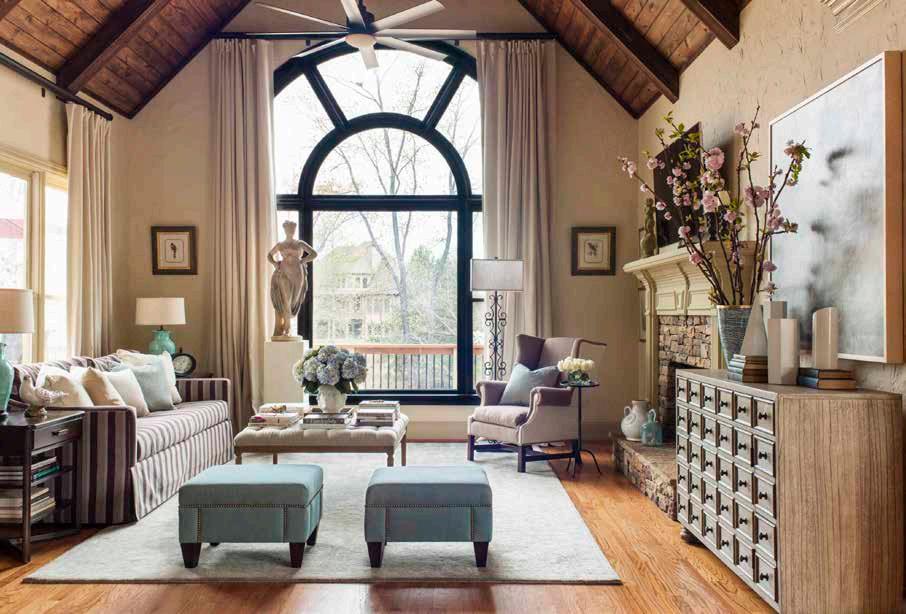
I loved the openness between the kitchen, breakfast nook, and keeping room. We wanted to not only keep these three spaces cohesive but also make the keeping room more of a

32 | AMERICAN LIFESTYLE MAGAZINE americanlifestylemag.com | 33
focal point. We accomplished this by adding beams, boards, and battens to the ceiling and painting the window arches black, which gave the room a wow factor.
How did you integrate the colors and textures to create such a warm, inviting space?
I prefer to use colors like blues and neutrals, some greens, and a little bit of mustard yellow to add some contrast. I find these colors relaxing, welcoming, and easy to live with. I used a mixture of textures and colors by incorporating wallpaper; various designs, patterns, attention-grabbing art pieces, and sculptures (one of which I added to the keeping room); and beautiful, flowing draperies.
How did you approach this project?
I needed to fully understand what their style was—did they prefer gold or silver accents? Bold or more neutral paint colors? I also asked them for pictures of the overall design styles they preferred. My client didn’t want to replace the floors or kitchen cabinets, so I had to work around these limitations. However, in the end, we accomplished the updated look while keeping with the traditional styles they preferred.
Which room did you find most interesting to decorate?
The dining room was an interesting room to work on due to its visually striking dark color palette as compared to the rest of the home, where neutral color tones were used. The old-world-



style chandelier, lamps, sconces, and dark furniture added to the vintage and dramatic quality of the room. I am a firm believer that dining rooms should stand out rather than blend in with the rest of the home.
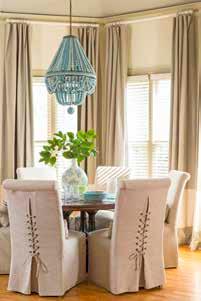
Can you explain how you incorporated the old furniture with the new pieces?
Most of the furniture was replaced other than the dining room table and chairs and a few other minor items. Since the goal was to keep a traditional feel, I incorporated antique art and furniture pieces such as an antique chest and embroidered armchairs with cabriole legs in the entrance hallway.
34 | AMERICAN LIFESTYLE MAGAZINE americanlifestylemag.com | 35
“I PREFER TO USE COLORS LIKE BLUES AND NEUTRALS, SOME GREENS, AND A LITTLE BIT OF MUSTARD YELLOW TO ADD SOME CONTRAST. I FIND THESE COLORS RELAXING, WELCOMING, AND EASY TO LIVE WITH.”
There is a lot of natural light in this home. How did you balance it with the lamps and overhead lights?
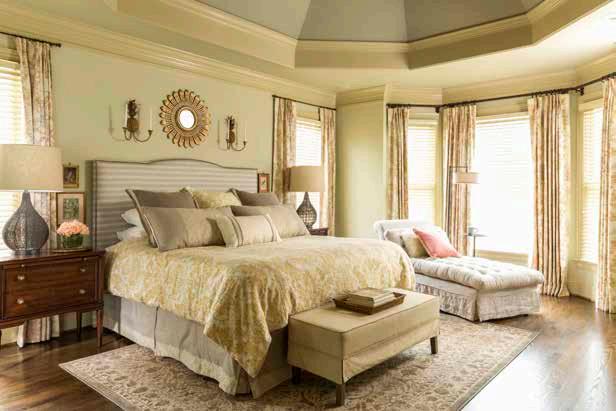
Fortunately, every room in the Hamilton Mill home has ample amounts of natural lighting, which draws your attention to the windows and makes the space feel alive and inviting. Because natural light was abundant, I was able to successfully combine floor lamps with table lamps and sconces. Most people don’t think of using sconces as a form of room lighting, but when mixed with contemporary decor, they give a room a warm, welcoming feel. Also, depending on the brightness of the natural room lighting, I will use varying types of window treatments to tone it down.
What’s your favorite design tip?
Mirrors are a great way to add natural light to a room. They can also make it appear larger because the light comes through the windows and reflects off them. Using oversized floor mirrors is also a great addition to any home, as well as hanging a mirror by the front door for people as they leave the home. Also, if you have artwork to display, using a mirror is a perfect technique to showcase it through its reflection on the opposite wall.
For more info, visit leahatkinsdesign.com

36 | AMERICAN LIFESTYLE MAGAZINE americanlifestylemag.com | 37
“Most people don’t think of using sconces as a form of room lighting, but when mixed with contemporary decor, they give a room a warm, welcoming feel.”
New Mexico’s Must-See Landmarks
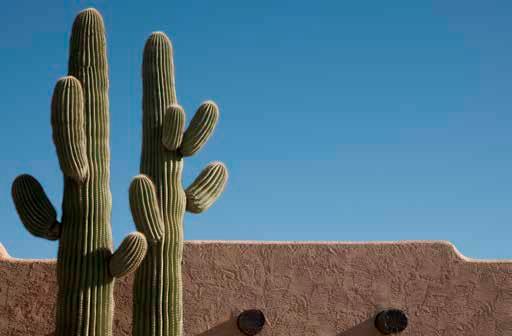
FOR TRAVELERS
The Land of Enchantment is one of the nation’s leastpopulated states, often dwarfed in tourism by iconic American locales that vacationers may more readily consider. However, New Mexico’s small population belies its unforgettable offerings: intriguing, ancient, and thrilling locations unlike anything else you’ve ever seen.
Carlsbad Caverns
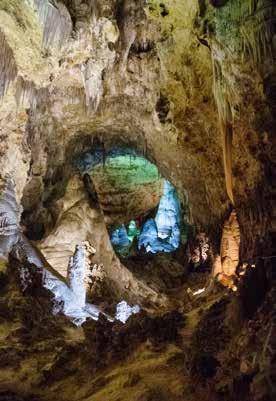
New Mexico celebrates exploration far underneath the earth’s crust at Carlsbad Caverns National Park, located less than an hour north of the Texas border. Extending more than 1,000 feet below ground, this grand complex of caverns deserves its worldwide fame. There are over thirty miles of subterranean passages through the park, where visitors can take solo hikes, reserve guided tours to learn about the history and discovery of these 120 caverns, or even go spelunking in the unnervingly named Slaughter Canyon.
If you dare, descend one and a half miles into the abyss that over 400,000 Mexican free-tailed bats call home from April to October. Then take in other notable feats of Mother Nature, including the world’s largest intact stalagmite. Save time to venture near the famous Bottomless Pit—a dark chasm into the depths of the earth that is not for the faint of heart.
The AndersonAbruzzo Albuquerque International Balloon Museum
One of New Mexico's newest landmarks, this unique museum was founded in 2005 to honor the city's legacy of daring aeronauts, or hot-air balloon flyers. It has dozens of exhibits dedicated to the science, history, and sport of hot-air ballooning, allowing visitors to get hands-on with the artifacts that make sky exploration by balloon possible.
Though the museum is open year-round, it’s best enjoyed as the headquarters for the annual Albuquerque International Balloon Fiesta. For nine days every October, New Mexico’s only large city is dwarfed by a sky alight with colorful hot-air balloons featuring classic vessels and quirky airborne art alike.

38 | AMERICAN LIFESTYLE MAGAZINE americanlifestylemag.com | 39
SEEKING A VACATION BEYOND THE ORDINARY, NEW MEXICO IS HAPPY TO OBLIGE, AND EVEN EXCEED, EXPECTATIONS.
written by andre rios photography by getty images, unless noted
The Roswell International UFO Museum
In the summer of 1947, unusual debris crashed into a ranch near Roswell, New Mexico. Military officials closed the site to the public and confiscated the residue, leading to rumors of alien life visiting Earth. The Roswell International UFO Museum is dedicated to the evidence surrounding the “Roswell incident,” as it came to be known, and features exhibits that just might change your perspective on what else—or who else—is out there.

This museum does an excellent job catering to believers and naysayers alike, as even those certain that its alien evidence is hokey can enjoy the extraterrestrial-themed, life-size dioramas and starry atmosphere. Surrounding the museum, the quirky city of Roswell leans into its claim to fame, featuring fun sights like alien streetlamps, cosmic street art, and UFO-shaped architecture.
The Very Large Array

Mysterious, bewildering, and strange, the Very Large Array complex may be an underrated destination due to one simple fact: it’s a collection of satellite dishes. However, one must behold the twenty-seven 240-ton, 82-foot-wide radio telescopes to fully understand their glory.
While these dishes scan the far reaches of the universe, reporting fascinating findings to the National Radio Astronomy Observatory, viewers can gaze at their unbelievable size. Veterans of Roswell’s UFO museum may feel tingling in the back of their necks as they witness these twenty-seven machines in motion.
You can learn all about the Very Large Array’s role in astronomical discovery at its visitor center, located fifty miles west of Socorro, New Mexico. To grasp the dishes’ significance, arrange a guided tour of the facilities and expansive grounds well in advance. These guided talks explain what the Very Large Array has unveiled of the cosmic wonders beyond our planet.
White Sands National Park

Spanning nearly 300 square miles, the dreamlike White Sands National Park hypnotizes visitors with vast dunes, boundless fields, and deep valleys of white, crystalline sand. A geographical oddity remnant of New Mexico’s prehistoric and extinct lakes, this destination is a must-see. In fact, White Sands is so bizarre and otherworldly that it has become a favorite of photographers, filmmakers, and musicians. You may be inspired to embrace your inner artist during your visit.
Be sure to show up with ample water, nutrition, and shade tents, because this park’s spartan campsites and five-mile Alkali Flat walking trail seem virtually absent of human civilization—spare the sunbathers, hikers, and artists drawn to this desert as if to visit another planet.
40 | AMERICAN LIFESTYLE MAGAZINE
americanlifestylemag.com | 41
© Kevin Burnell
Wheeler Peak

Another fixture of this state’s natural splendor is Wheeler Peak, which proudly dominates the New Mexico landscape. This is the tallest summit of the Sangre de Cristo Mountains, the southernmost range of the Rocky Mountains—at 13,161 feet, it dwarfs its surroundings in an already elevated state. You can dare to traverse its rugged terrain for breathtaking views of the landscape, take a casual hike through about 20,000 acres of forested wilderness flocking Wheeler Peak, and even observe inhabitants like elk, marmots, pika, and golden eagles.
This landmark also lends itself to an excellent day trip to Santa Fe, the state’s popular capital city, which sits about one and a half hours southwest of Wheeler. For a taste of adventure that’s slightly less daring, spectate Wheeler Peak and the surrounding Rocky Mountains from one of the many ski resorts in the area, including Taos and Angel Fire.
The Rio Grande Gorge Bridge
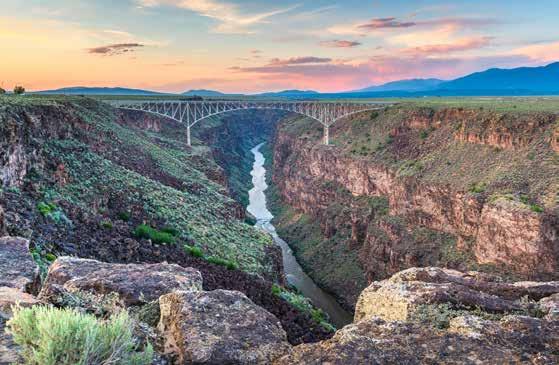
Daring adventurers can also visit an engineering wonder forty-five minutes west of Wheeler Peak that spans the storied Rio Grande River. Those who fear heights, beware: the Rio Grande Gorge Bridge, which connects two mountainous shores high above the riverbed, is one of the nation’s highest bridges. A whopping 650 feet high and over 1,200 feet long, it offers a pedestrian walkway for those who dare traverse it. You can also commemorate your victory over vertigo at one of the gift shops at either end of the rugged valley far below.
Taos Pueblo

About twenty minutes east, you’ll discover one of the nation’s oldest surviving human-made landmarks, Taos Pueblo—a series of preserved, iconic adobe homes dating as far back as 1000 AD. A site revered by the Pueblo people native to the region, these undulating stories of ancient structures are some of the finest, most intact examples of classic adobe architecture anywhere.
Tribal guides lead tours of the grounds, during which they share details about the ancient homes’ history, composition, and even current significance. Because the site sits upon tribal lands, it is closed from February to mid-April for private events and ceremonies. And although walking tours of the grounds are free, donations are highly suggested. To memorialize your visit, take home a piece of pottery, jewelry, or decor handmade by the descendants of those who have occupied this land for centuries.
For more info, visit newmexico.org
42 | AMERICAN LIFESTYLE MAGAZINE americanlifestylemag.com | 43
accessible luxury
the beauty and opulence of Parisian style so much, she transformed her home into her own slice of Paris.
Unsurprisingly, in her blog, Monica Wants It, she shares her secrets for how to make a home look sophisticated on a budget. She discusses how anyone can transform their space into their own Versailles with vintage and thrifted items.

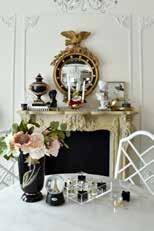

How does Parisian style affect your design choices?
It influences me because people often think they need a grand mansion to have a place that feels elegant and opulent. My husband and I live in a home that’s about 2,000 square feet— it’s not massive—but I find ways to incorporate Parisian moments all over it. Every little pocket of a French home is special. They have smaller homes, yet they have grand decor. They stick to statement pieces, and that’s what I try to do in my home too.
How do you describe your style?
It’s accessible luxury. I have a dog and a husband, so nothing in my home is too precious. I would also describe it as traditional American with a French twist. I like very ornate baroque picture frames and artwork and a variety of rich colors, textures, and textiles.
When did you first learn about design?
I grew up poor and shared a room with my mom in our apartment, and my grandmother had the other bedroom. I didn’t have my own bedroom until I went to college. It was there that I binge-watched the TV show Trading Spaces. I focused on what the designers did on the show with so little money— they were very creative. It showed me that if I were willing to put in some elbow grease, I could make my home into anything I wanted. I also read a lot of design books. Candice Olson is a huge influence, as are Sarah Richardson and Eddie Ross.

What do you like about decorating with thrifted furniture and decor?
I like shopping secondhand so I can have a home that looks unique. I also love that my money will stretch further. If I bought a nice lamp from a major retailer, I would spend at least $300. But I can find a $5 brass lamp at a thrift shop and make it look new with Brasso polish. Also, as someone
44 | AMERICAN LIFESTYLE MAGAZINE americanlifestylemag.com | 45
WITH SELF-TAUGHT DIY SKILLS AND SECONDHAND FINDS, BLOGGER MONICA BENAVIDEZ HAS STYLED HER MODEST TEXAN HOME TO RESEMBLE A POSH PARISIAN APARTMENT.
TEXAS BLOGGER MONICA BENAVIDEZ LOVES
interview with monica benavidez written by lauren kim photography courtesy of monica benavidez
who thrifts a lot, I notice so much disposable home decor and sometimes worry about where all this stuff will end up—another reason I want to focus more on giving new purpose to things. I try to buy timeless items so I will like them now and ten years from now, which helps reduce consumption.
You bought your vintage Parisian desk at a fraction of its original price. How did you do that? You need to know your market. For example, where I live, farmhouse and Texan rustic styles are popular, but they’re not for me. I saw the desk come up on Facebook Marketplace for close to $2,000. I knew nobody would snatch it up. Six weeks later, it dropped to $750. When it fell to $350, I picked it up the same day. You must be willing to wait. If I know something will sell quickly, I will offer an extra five or ten dollars. Most of the time, though, prices go down. You should follow your gut.
How and where do you shop for your vintage finds?
I love thrift stores and shops that support charities. I like going to estate sales, too, especially on half-off day, which is usually on the last day of a sale because they are trying to get rid of everything, so there will be bargains. I always look for beautiful frames that can be repurposed. I also advise buying
old trophies because the bases tend to be made of real marble that you can use as lamp bases. Sometimes I find original oil paintings and beautiful cut crystal and glass.
What are your tips for buying secondhand furniture?

I recommend that your first piece be an inexpensive one, so you’ll only be out a few dollars if it doesn’t go well. I also suggest buying solid-wood furniture— if you pull out a drawer and the joints are dovetailed, that’s quality. You can often find the brand on the bottom of a piece, so get familiar with brands. For example, I found an American of Martinsville burl-wood nightstand, which sells for hundreds of dollars, but I only paid $25 for it.
Which of your reclamation projects is your favorite?
I found a sofa that I tried cleaning by hand with dish soap, but it got stained. So I dyed the entire sofa a gorgeous peacock green one weekend. But it didn’t fit where I wanted it to go, so I sold it for more than four times what I paid for it three days after staining it. It was a French sofa with claw feet and was very pretty and ornate, so I wish I had found a way to keep it.
What inspired your beautiful patio makeover?

I went to Paris in March 2020. It was wintery and cold, but I noticed that there was so much green everywhere, even in the middle of winter, including a lot of ivy, boxwood on the walls, and topiaries. I liked that cozy feel and wanted to bring that and the happy moments I had in Paris to my backyard in Corpus Christi. So over a weekend, my husband and I painted our cement-slab patio with big squares to give it a secret garden feel, and I paired faux boxwood panels on the walls with a fountain. The patio was an
easy project—if you don’t want to do a checkered design, you can paint stripes or stencil a rug. I love sitting on my patio now and listening to the fountain while drinking a glass of wine.
For more info, visit monicawantsit.com
46 | AMERICAN LIFESTYLE MAGAZINE americanlifestylemag.com | 47
“I saw the [vintage Parisian] desk come up on Facebook Marketplace for close to $2,000. I knew nobody would snatch it up. Six weeks later, it dropped to $750. When it fell to $350, I picked it up the same day.”
Welcome to American Lifestyle magazine.
American Lifestyle is a celebration of the flavor and flair of life in the United States, that takes the reader on a journey of the nation's sights, sounds, smells, and tastes. This 48-page publication features articles on interior design, travel, technology, restaurants, and culture
Entertaining writing coupled with gorgeous photography makes this magazine a must read
This magazine provides me with the chance to connect with all of the friends and clients that I have had the opportunity to know over the years. If you are interested in receiving your own free subscription of this magazine please e-mail or call me with your name and home address, and I will add you to my mailing list. It is delivered to your home ever y other month with no obligation.
Feel free to share this issue with friends and colleagues and encourage them to reach out to me I would love to hear what they think of American Lifestyle magazine too
I look for ward to hearing from you
Yogesh Khare
Yogesh Khare Team Lead | Founder
REALTOR® DRE #02044237
A Home You Will Love!
Top Agents in Bay Area
COASTING IN COLORADO
(408) 888-3855
 written by alexa bricker photography by jack affleck
written by alexa bricker photography by jack affleck
Yogesh@Califor niaKhare.com
www.YogeshKhare.com and www.Califor niaKhare.com
Facebook: https://www.facebook.com/Califor niaKhareGroup
IF YOU’RE A FAN OF ROLLER COASTERS, you’re likely familiar with the ride’s characteristically sharp twists and turns and belly-churning drops. Located in Glenwood Springs, Colorado, deep in the Rocky Mountains, the Alpine Coaster takes the traditional coaster experience to the next level by allowing riders to control the speed of their cars. Gravity does the bulk of the work as passengers race down the track, but a pair of hand brakes affixed to either side of the car allows riders to slow their speed.
California Khare Real Estate Group Los Altos, CA 94022

The Alpine Coaster has been a popular ride at Glenwood Caverns Adventure Park since 2005. It was originally created as a creative and excitementfilled way for visitors to pass time while waiting for the park’s cave tours. The coaster’s cars are fixed to a track that spans 3,400 feet of hilly terrain that, during spring and summer, is dotted with colorful wildflowers—making for an exhilarating multisensory experience.
For more info, visit glenwoodcaverns.com

48 | AMERICAN LIFESTYLE MAGAZINE
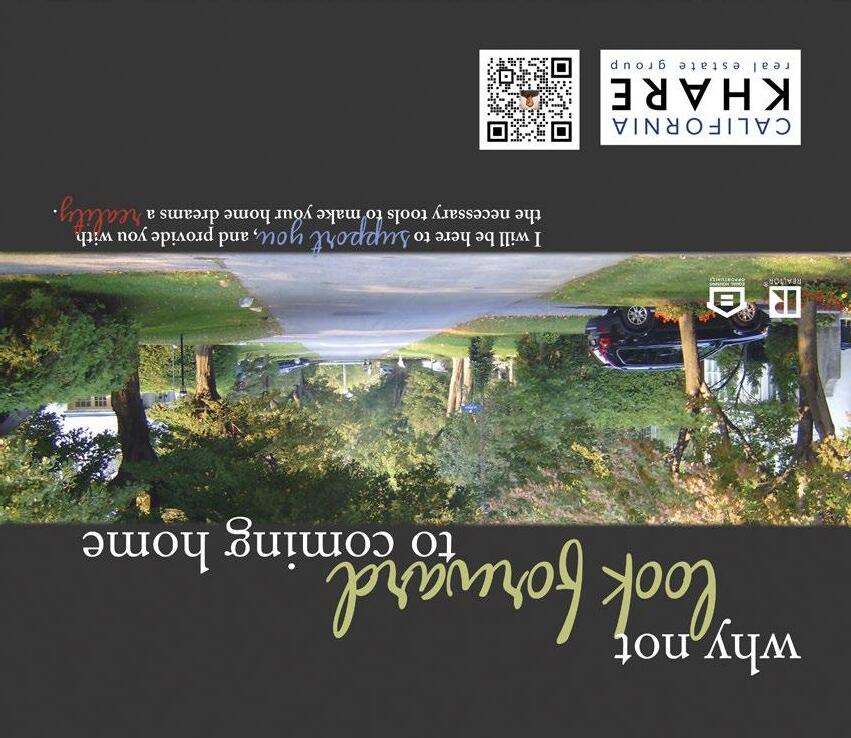





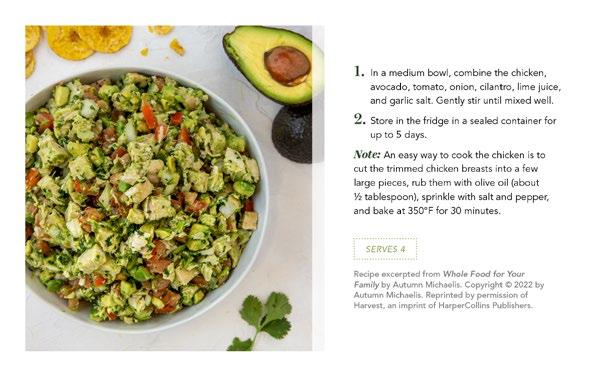
tear off your y Reci pe Card or to share. eKhar TOR® DRE #02044237 ogesh@Califor e.comniaKhar e.comogeshKhar .Califor e.comniaKhar (408) 888-3855 (408) 888-3855 Yogesh@Califor niaKhare.com www YogeshKhare.com and www CaliforniaKhare.com California Khare Real Estate Group Los Altos, CA 94022
of Tear Out Card 2 Back of Tear Out Card 2
Yogesh Khare, Team Lead | Founder REALTOR® DRE #02044237 Front
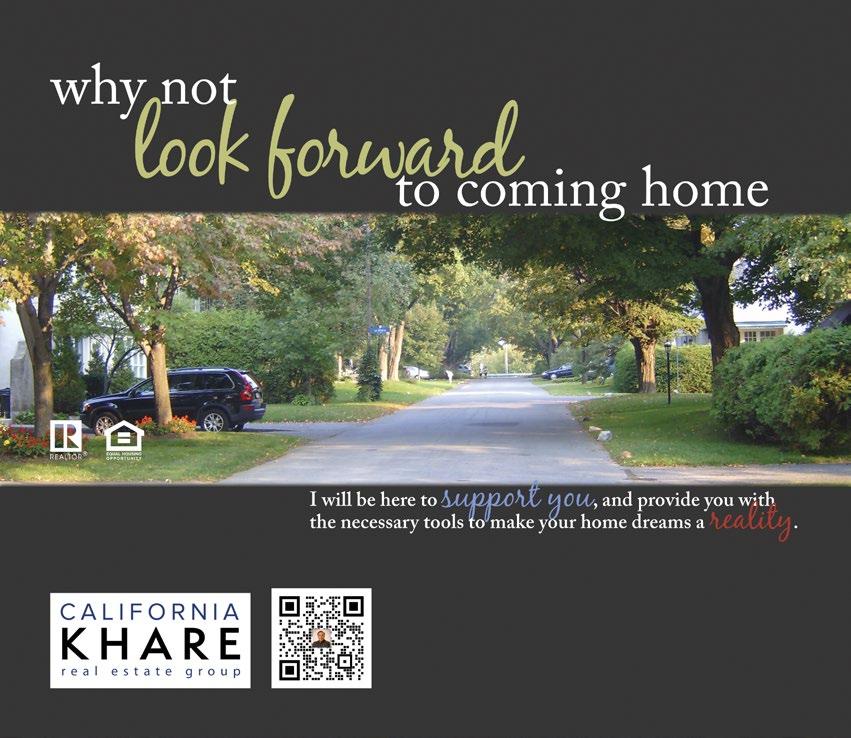

Yogesh Khare REALTOR® DRE #02044237 Yogesh@Califor niaKhare.com www.YogeshKhare.com www.Califor niaKhare.com (408) 888-3855
Yogesh Khare
Califor nia Khare Real Estate Group Los Altos, CA 94022

















 written
written






















































 written by alexa bricker photography by jack affleck
written by alexa bricker photography by jack affleck






